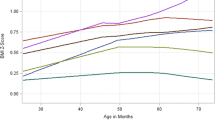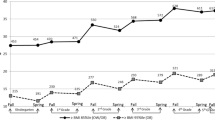Abstract
Much of the research examining the patterns, timing, and socioeconomic characteristics of child overweight has been limited by the lack of longitudinal nationally representative data with sufficiently large or diverse samples. We used the Early Childhood Longitudinal Study-Kindergarten Cohort (ECLS-K), a nationally representative sample of US kindergartners, to identify three distinct patterns of weight gain from kindergarten through eighth grade. The largest group (boys: 59%, girls: 55%) was characterized as having consistently normal weight whereby BMI percentile remained below the 85th percentile. The remaining children (boys: 41%, girls: 45%) fell either into a class characterized as always overweight/at risk of overweight (boys: 27%, girls: 25%) or gradually becoming overweight/at risk for overweight (boys: 15%, girls 20%). We found some evidence that the relationship between socioeconomic status and children’s health may operate differently across gender. Among girls, low parental income and education were both significant risk factors for the gradual onset of overweight after beginning Kindergarten. Parental income or changes in parental income were not related to boys’ risk of developing overweight after entering Kindergarten; only parents’ education. We found that while children of immigrants display higher levels of overweight/at risk for overweight at each grade level, the children of immigrant parents who have had less exposure to the US were more likely to experience early and sustained overweight throughout elementary and middle school, particularly among boys. High rates of overweight as early as kindergarten, combined with race/ethnic differences suggest that interventions should focus on pre-school children’s environments.


Similar content being viewed by others
References
National Center for Health Statistics. (2004). Prevalence of overweight among children and adolescents: United States, 1999–2002. Report available online at http://www.cdc.gov/nchs/products/pubs/pubd/hestats/overwght99.htm Center for Disease Control: Washington, DC.
Wisemandle, W., Maynard, L. M., Guo, S. S., & Siervogel, R. M. (2000). Childhood weight, stature, and body mass index among never overweight, early-onset overweight, and late-onset overweight groups. Pediatrics, 106, E14.
Whitaker, R. C., Wright, J. A., Pepe, M. S., Seidel, K. D., & Dietz, W. H. (1997). Predicting obesity in young adulthood from childhood and parental obesity. The New England Journal of Medicine, 37(13), 869–873.
Field, A. E., Cook, N. R., & Gillman, M. W. (2005). Weight status in childhood as a predictor of becoming overweight or hypertensive in early adulthood. Obesity Research, 13(1), 163–169.
Freedman, D. S., Khan, L. K., Dietz, W. H., Srinivasan, S. R., & Berenson, G. S. (2001). Relationship of childhood overweight to coronary heart disease risk factors in adulthood: The Bogalusa Heart Study. Pediatrics, 108, 712–718.
Mustillo, S., Worthman, C., Erkanli, A., Keeler, G., Angold, A., & Costello, J. (2003). Obesity and psychiatric disorder: Developmental trajectories. Pediatrics, 111, 851–859.
Li, C., Goran, M. I., Kaur, H., Nollen, N., & Ahluwalia, J. S. (2007). Developmental trajectories of overweight during childhood: Role of early life factors. Obesity, 15, 760–771.
Ogden, C. L., Flegal, K. M., Carroll, M. D., & Johnson, C. L. (2002). Prevalence and trends in overweight among US children and adolescents, 1999–2000. The Journal of the American Medical Association, 288(14), 1728–1732.
Gordon-Larsen, P., Harris, K. M., Ward, D. S., & Popkin, B. M. (2003). Acculturation and overweight-related behaviors among Hispanic immigrants to the US: The National Longitudinal Study of Adolescent Health. Social Science and Medicine, 57, 2023–2034.
Zhang, Q., & Wang, Y. F. (2004). Socioeconomic inequality of obesity in the United States: Do gender, age, and ethnicity matter? Social Science and Medicine, 58, 1171–1180.
Chen, E., Martin, A. D., & Matthews, K. A. (2006). Understanding health disparities: The role of race and socioeconomic status in children’s health. American Journal of Public Health, 96, 702–708.
Whitaker, R. C., & Orzol, S. M. (2006). Obesity among US urban preschool children: Relationships to race, ethnicity, and socioeconomic status. Archives of Pediatrics and Adolescent Medicine, 160(6), 578–584.
Balistreri, K., & Van Hook, J. (2009). Socioeconomic status and body mass index among hispanic children of immigrants and children of natives. American Journal of Public Health, 99(2), 1–8.
Van Hook, J., & Balistreri, K. (2007). Immigrant generation, socioeconomic status and economic development of countries of origin: A longitudinal study of body mass index among children. Social Science and Medicine, 65, 976–989.
Van Hook, J., Baker, E., Altman, C. Does it begin at school or home? Institutional origins of overweight among young children in immigrant families. In R. Takanishi, & L. G. Elena (Eds.), Diversity, and Education.
Glass, T. A., & McAtee, M. J. (2006). Behavioral science at the crossroads in public health: Extending horizons, envisioning the future. Social Science and Medicine, 62, 1650–1670.
Poskitt, E. M. E. (2000). Body mass index and childhood obesity: Are we nearing a solution? Acta Paediatrica, 89, 507–509.
Braveman, P. B., Cubbin, C., Egerter, S., Chideya, S., Marchi, K. S., Metzler, M., et al. (2005). Socioeconomic status in health research: One size does not fit all. The Journal of the American Medical Association, 294, 2879–2888.
Oken, E., & Gillman, M. W. (2003). Fetal origins of obesity. Obesity Research, 11(4), 496–506.
Danner, F. (2008). National longitudinal study of the association between hours of TV viewing and the trajectory of BMI growth among US children. Pediatric Psychology, 33, 1100–1107.
Anderson, P., Butcher, K., & Levine, P. (2003). Maternal employment and overweight children. Journal of Health Economics, 22, 477–504.
Baker, E., Balistreri, K., & Van Hook, J. (2007). Maternal employment and overweight among hispanic children of immigrants and children of natives. Journal of Immigrant and Minority Health, 11(3), 158–167.
Crockett, S. J., & Sims, L. S. (1995). Environmental influences on children’s eating. Journal of Nutrition Education, 27(5), 235–250.
Strauss, R., & Pollack, H. A. (2001). Epidemic increase in childhood overweight, 1986–1998. Journal of the American Medical Association, 286(22), 2845–2848.
Muthen, B. (2001). Second-generation structural equation modeling with a combination of categorical and continuous latent variables: New opportunities for latent class/latent growth modeling. In L. M. Collins & A. G. Sayer (Eds.), New methods for the analysis for change: Decade of behavior (pp. 291–322). Washington, DC: United States.
Nagin, D. S. (1999). Analyzing developmental trajectories: A semi-parametric, group-based approach. Psychological Methods, 4, 139–177.
Nagin, D. S. (2005). Group-based modeling of development (pp. 1–199). Cambridge, Massachusetts: Harvard University Press.
Kimm, S. Y. S., Barton, B. A., Obarzanek, E., et al. (2001). Racial divergence in adiposity during adolescence: the NHLBI growth and health study. Pediatrics, 107(3), E34.
Van Hook, J., & Baker, E. (2010). Big boys and little girls: Gender, acculturation, and weight among young children of immigrants. Journal of Health and Social Behavior (forthcoming).
Popkin, B. M., & Doak, C. M. (1998). The obesity epidemic is a worldwide phenomenon. Nutrition Reviews, 56, 106–114.
Doak, C. M., Adair, L. S., Bentley, M., Monteiro, C., & Popkin, B. M. (2005). The dual burden household and the nutrition transition paradox. International Journal of Obesity, 29(1), 129–136.
Melgar-Quiñonez, H. R., & Kaiser, L. L. (2004). Relationship of child feeding practices to overweight in low-income Mexican-American Preschoolers. Journal of the American Dietetic Association, 104, 1110–1119.
Bose, J., & West, J. (2002). Examining additional nonresponsive bias introduced through attrition bias. In Proceedings from the Joint Statistical Meetings 2002. New York.
Acknowledgments
This research was supported in part by a grant from the National Institutes of Health (R21 HD058142-01A1). Support was also provided by the Center for Family and Demographic Research at Bowling Green State University which has core funding from The Eunice Kennedy Shriver National Institute of Child Health & Human Development (R24HD050959-01).
Conflict of interest statement
The authors have no conflict of interest.
Author information
Authors and Affiliations
Corresponding author
Rights and permissions
About this article
Cite this article
Balistreri, K.S., Van Hook, J. Trajectories of Overweight Among US School Children: A Focus on Social and Economic Characteristics. Matern Child Health J 15, 610–619 (2011). https://doi.org/10.1007/s10995-010-0622-7
Published:
Issue Date:
DOI: https://doi.org/10.1007/s10995-010-0622-7




